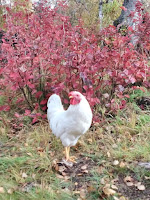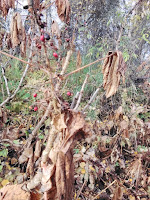This year's fall has been warm. Usually, our first frost occurs around fall equinox (Sept 21), but this September, none. Temperatures occasionally dipped into the high 30s at night and ascended to the mid- 50's almost every day. It rained almost every day or night for brief periods, but we were able to tackle projects and enjoy kayaking between the shower bursts.
September chores included mulching the outdoor gardens with soiled straw from the chicken coop and rabbit hutches, and then lining the nesting boxes with an insulating layer of cardboard topped with fresh hay. I will add dry birch leaves when all have fallen in October. Mulching ensures overwintering by perennials (like mint and strawberries, anise hyssop and feverfew) and even seeds (like sunflowers) and seed potatoes that will sprout when the soil warms again.The chickens start molting in September. This is when they shed feathers and grow new ones. Here, for the breeds I raise, the process lasts about six weeks. The Americaunas in particular look AWFUL during this time – turkey-like bare necks, soft grey underfeathers flying every time they scoot with any speed. The black Jersey Giants show white needle like pin feathers along their necks. The process of growing new feathers is arduous enough that they stop or slow egg laying during this time. So, from 9 hens, we net only 3 eggs per day. Fortunately, earlier this year I laid aside 60 eggs and glassed them for long term storage. This is an old fashioned process of storing raw eggs in a water and pickling lime solution without refrigeration. I check the eggs every few months and they store safely, for several years. The oldest have lasted 9 months so far, and the taste and texture of the few I have used are unimpaired. Note: I don't refrigerate any of my home grown eggs.
Moose hunting is allowed in September and each year, as if they know this, we see or hear a bull moose on our property calling for a cow... for several days AFTER the hunting season ends. This morning (Oct. 1), about 5 am, I was awakened by his guttural “huh – huh – huh” cry in the woods beyond the chicken coop. Bryan went outside to call him, just for fun, and the two of them sang a duet for several minutes.
Because the pike in our lake have cannibalized each other, severely depleting the size of both the population and the individual fish, this year we decided to follow an animal trail through the woods that intersects with another one that leads to a creek about two miles away. In addition to accessing fish, the trail may help us access harvestable birch and spruce, chaga, and plants among which I forage for food and home remedies, like willow, saxifrage, and creekside plants that don't grow on my property. I love the scent of poplar buds and wonder if I might score some of those in springtime. Fall is the best time to clear trails: no mosquitoes, no yellow jackets, and the grasses, ferns, and bushes are dying back for longer views of the terrain and deeper views of the deadfall beneath the tall grasses.
I felt like we were Hansel and Gretel, but instead of a trail of bread crumbs, we marked our way with bright pink ribbons of flagging tape on branches overhead, finding bits of old orange ones that had preceded the endeavor by several years. The first afternoon, we flagged the sinuous path over lumpy hummocks of ferns, through thick stands of grass, and, around downed trees and thickets of berry bushes, devil's club, and dense growths of alder. Fortunately, we encountered no deep wet pools, even after so much rain, but we bounced and occasionally tripped over the lattice of many years of devil's club roots. We connected with the other trail and walked it until several low wet pools blocked our way. We will “corduroy” them by laying alder across the muddy pools, to provide traction and a kinda-sorta flat surface. Mother Nature reclaims what is hers pretty quickly, so we will need to maintain this path more regularly in the future. I look forward to walking it for exercise this winter, and for resources next year. It was very satisfying to spend these afternoons in autumnal woods.
Usually we retain our little plane until early October, but this year it developed a worrisome oil leak, so we flew it to our mechanic in mid-Sept and decided to leave it there for the winter. We flew home with an air taxi service and are now settled in until May, when the lake thaws and we can fly to town to replenish depleted supplies. In the meantime, we have two freezers full of meat and cheese, and many linear feet of shelves groaning under the weight of mason jars filled with gallons of summer fruit, vegetables, broth, and chutneys. We look forward to a cozy winter, with projects and learning that we postpone for just that time of year.




No comments:
Post a Comment